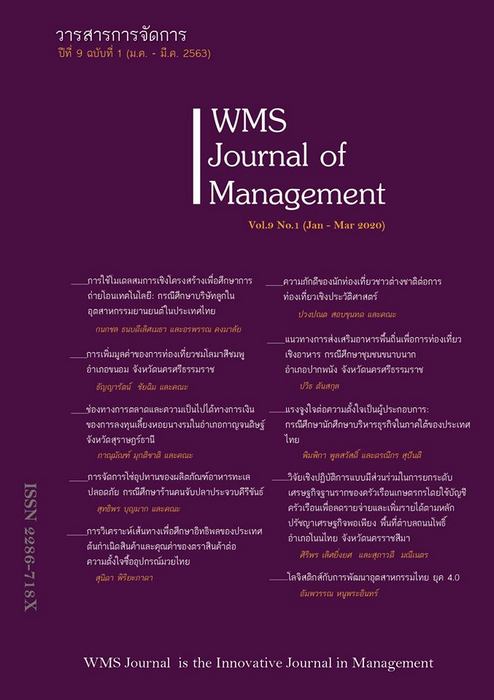Guidelines to Promoting Local Cuisine for Gastronomic Tourism: Case study of Khanab Nak Community, Pak Phanang District, Nakhon Si Thammarat Province
Main Article Content
Abstract
The objectives of this research were 1) to explore the local raw ingredients used for cooking 2) to study local food and to lead to the creation of community food identity and 3) to give recommendations for promotion and development of Gastronomic tourism for Khanab Nak community, Pak Phanang district, Nakhon Si Thammarat province. The qualitative research was used to examines the accuracy of the data using the triangulation principle. The primary data were collected from the residences in the area’s local villagers, community leaders and local government organizations, using participatory observation methods, in-depth interviews and focus group discussion. Furthermore, secondary data were examined by researching documents, texts, articles, and related research.
The study found that Khanap Nak Community has potential of local food identity and is ready to promote for tourism in the area. By using creative economy concepts to create a tourism which called gastronomic tourism. Due to unique local wisdom and food culture that inherited into a uniqueness. Also the processed products derived from Nipa palm plants such Nipa palm sugar and Nipa plam veinegar with a variety from the ecosystems making it an outstanding raw ingredients for cooking, aside from many other sourses. According to the study, the researcher has propose the guidelines for promoting gastronomic tourism by proposing the concept for conservative, rehabilitation, dissemination and creation of added value. The approches including establishing new activities for tourists in Khanab Nak community to be used to promote tourism in the form of gastronomic tourism
Article Details
References
Chamnancha, B. (2018). Gastronomy Tourism: Thailand's Competitiveness. Apheit Journal, 24 (1), 103-116.
Chimbanrai, H., & Wongsarot, R. (2016). Potential of Local Food and Guidelines for Tourism Promotion through local food of Nan province. International Thai Tourism Journal, 11(1), 37-53.
Department of Tourism, Ministry of Tourism and Sport, Thailand. (2017). Creative touism destination management. Bangkok: Ministry of Tourism and Sport, Thailand.
Designate Areas for Sustainable Toursim. (2016). Gastronomy Tourism. Bangkok: Cocoon and Co Ltd.
Donald, G., Richard, N., & Tommy, D. (2014). Foodies and Food Tourism. Oxford: Goodfellow Publisher Ltd.
Fox, R. (2007). Reinventing the gastronmic identity of croation tourist destinations. International Journal of Hospitality Management, 26(3) 546-559.
Hall, C. (2003). Wine, Food and Tourism Marketing. New Tork: The Haworth Hospitality Press.
Hall, C., & Mitchell, R. (2005). Gastronomic tourism: Comparing food and wine tourism experiences. Oxford: Elsevier Butterworth Heinemann.
Hall, M., Shaples, L., Mitchell, R., Macionis, N., & Cambrourne, B. (2003). Food Tourism Around the World: Developmemt, Management and Markets. Oxford: Butterworth-Heinemann.
International Culinary Tourism Association. (2006). What is food tourism? Retrieved from http://www.worldfoodtravel.org/what-is-food-tourism
Jalis, M., Othman, Z., Zahari, M.S., & Zulkifly, M. (2007). Gastronomic product as tourist motivation factors: An opportunity to Malaysia. Tourism Educators of Malaysia Conference, 25-45.
Kivela, J., & Crotts, R. (2006). Tourism and Gastronomy: Gastronomy's Influence on how tourists experience a destination. Journal of Hospitality and Tourism, 30(3), 354-377.
Long, L. (2004). Culinary Tourism. Lexington, KY: The University Press of Kentucky.
OECD. (2014). "Forward", in Tourism and the Crative Economy. Paris: OECD Publishing.
Pakdeepinita, P. (2010). The Potentiality of Community Tourism Interpretation: Rong Hai Community, Phayao Province. Nasesuan University Journal, 18(2), 82-90.
Pearson, D., & Pearson, T. (2016). Branding food culture: UNESCO creative cities of gastronomy. Journal of International Food and Agribusiness Marketing, 28(2), 164-176.
Phakdee-auksorn, P. (2012). Tourism Motivation Theory and Food Tourism. Journal of Management Sciences, 29(2), 129-148.
Phithakwapi, K. (2013). Type of Thai Cuisine. Retrieved from http://krukaewthaicooking.blogspot.com/2013/06/blog-post_231.html
Rand, G., Health, E., & Alberts, N. (2003). The role of local and regional food in destination marketing: a South African situation analysis. Journal of Travel and Tourism Marketing, 14(3-4), 97-112.
Raymond, C. (2010). What's in a Name? The Origins of the Term 'Creative Tourism'. Santa Fe: Sunstone Press.
Richards, A., & Hjalager, G. (2002). Tourism and Gastronomy. London: Routledge.
Richards, G. (2012). Global Report on Food Tourism: volume four. Spain: World Tourism Organization.
Richards, G., & Marques, L. (2012). Exploring Creative Tourism: Editors Introduction. Journal of Tourism Consumption and Practices, 4(2), 1-11.
Robinson, M., & Novelli, M. (2005). Niche Tourism: Contemporary Issues, Trends and Cases. Oxford: Butterworth-Heinemann.
Robinson, P., & Heitmann, S. (2011). Research themes for tourism. Oxfordshire, UK: CABI International.
Sakdadech, S. (2006). Ahan Thongthin (Local Cuisine). Chanthaburi: Rambhai Barni Rajabhat University.
Scarpato, R. (2002). Gastronomy as a tourist product: The perspective of gastronomy studies. London: Routledge.
Shalini, D., & Duggal, S. (2015). A review on Food tourism quality and its associated forms around the world. African Journal of Hospitality, Tourism and Leisure, 4(2), 1-12.
Suwannarat, S. (2018, September 15).Personal interview on Guidelines to Promoting Local Cuisines for Gastronomy Tourism.
Telfer, D., & Wall , G. (1996). Linkages between tourism and food production. Annals of Tourism Research, 23(3), 635-653.
Thongoupragarn, B. (2018). Local Food: Food Security in the Cultural Dimension: A case study of Baan Taling Daeng Community, Kanchanaburi Provience. Princess of Naradhiwas University Journal of Humanities and Social Sciences, 5(special), 107-109.
Tilden, F. (1977). Interpreting our heritage. United States of America: University of North Carolina Press.
Tourism Authority of Thailand. (2018). Tourism Statistics in Thailand. Retrieved from https://www.tourismthailand.org/about-Thailand/About-TAT/TAT-informative
Wolf, E. (2002). Culinary tourism: A tasty economic proposition . Portland: International Culinary Tourism Taskforce.


